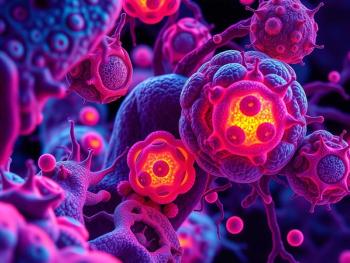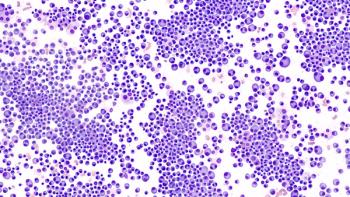
NCCN Guidelines for Molecular Testing in CLL
Lisa Nodzon, PhD, ARNP, AOCNP, and Javier Pinilla-Ibarz, MD, PhD, provide insight on NCCN guideline recommendations for molecular testing in CLL and discuss the prevalence of testing for cytogenetic abnormalities.
Episodes in this series

Javier Pinilla-Ibarz, MD, PhD: What are you thinking about the NCCN [National Comprehensive Cancer Network] guidelines recommendations for molecular testing and prognosis? Many people are asking, “What are we going to do with the testing?” There is a prognostic implication about when the patient may require therapy. What do you think about this issue?
Lisa Nodzon, PhD, ARNP, AOCNP: It is super important that the NCCN guidelines and the iwCLL [International Workshop on Chronic Lymphocytic Leukemia]guidelines are followed when it comes to testing for the patients. Most importantly, we are upfront in our newly diagnosed patients because it gives us prognostic information to stratify our patients out into low, intermediate, or high risk. Most importantly, we’re always seeking to look out for those high-risk patient populations because those are the patients that we worry about the most. We recognize that they’ll require therapy sooner rather than later. We recognize that therapy won’t hold them forever. We always have to be one step ahead of them. In all of the patients with recommendations, FISH [fluorescence in situ hybridization] testing for the newly diagnosed patient is important. Initially, we had just mentioned the IGVH [immunoglobulin variable heavy chain gene] status and then because we’re an academic institution, we will perform NGS [next-generation sequencing] testing. In addition to that, with the NGS testing, we’re looking for TP53 mutations. We know that it’s rare to see this and the TP53 mutation or deletion 17p in the treatment-naïve patient population. But the guidelines particularly should be followed for the patient at time of relapse, or at least time for that next line of therapy where the repeat FISH needs to be performed, as well as the NGS looking for that TP53 mutation because, most importantly, this is what’s going to guide that next line of therapy for the patient. Obviously, bone marrow biopsies do have an importance for the patient when it comes time for therapy and for restaging. In the absence of other things of unknown cytopenia, for example, it is not indicated for newly diagnosed patients, but the bone marrow biopsy does provide valuable information at the time of therapy, particularly if the patient has a complex karyotype, which confers high-risk disease. Ultimately, performing the cytogenetic test gives us prognostic information. But most importantly, it does guide therapy for patients and particularly pulls out that patient population that harbors those high-risk disease features, which is the patient population that we have to stay one step ahead of. We recognize that they do define a particular niche of therapy since some therapy options may not be bountiful for them.
Javier Pinilla-Ibarz, MD, PhD: You make an excellent comment. We always use NCCN guidelines and FISH. We use FISH because we believe that normal karyotype cannot be done because the proliferative rate of CLL is low, and you cannot have metaphases. However, with the new technology of CpG stimulated metaphases allow us to characterize a new complexity. Many times, it can be associated independently of depression of TP53 or del [deletion] 17p. It’s something important that we can do in the bone marrow but, in terms of the situation, it can be done in the peripheral blood in our patient. At the time, we discuss treatment options. You mentioned that it is true that the rate of the TP53 mutation is very low. It’s around 4% and at many times is associated, but may not be associated, which is the key message with del [deletion] 17p. We know that in the pathology report that we read all of the time, pathology is trying to say that del [deletion] 17p is last TP53 mutation, but we know that this technique is done by FISH. They are not doing molecular testing and molecular testing is an independent test besides the del [deletion] 17p. Suddenly, in this consideration, they are quite important as well the IGHV mutation status when some community oncologists still rely on chemoimmunotherapy, something that went away in our academic solution and many other academic institutions across the United States. We know that chemoimmunotherapy is being used in the community including BR [bendamustine (Treanda), rituximab (Rituxan)] and sometimes FCR [fludarabine, cyclophosphamide, rituximab]. We know that these chemoimmunotherapy strategies are almost hours contraindicated. One of the main classic ones is the TP53 mutation of del [deletion] 17p. In IGHV unmutated it is questionable how to use these chemoimmunotherapy strategies because they can bring more complexity in the genomic abnormalities as you pointed out on the relapse setting. It’s important that we know that the prevalence of testing for cytogenetic abnormalities and IGHV mutation status as mentioned is still not optimal in many institutions I would say that it is in more institutional community oncology practices where there still is work to be done to make sure that we characterize patients properly and we can offer the best therapeutic strategy.
Transcript Edited for Clarity
Newsletter
Stay informed on drug updates, treatment guidelines, and pharmacy practice trends—subscribe to Pharmacy Times for weekly clinical insights.





















































































































































































































